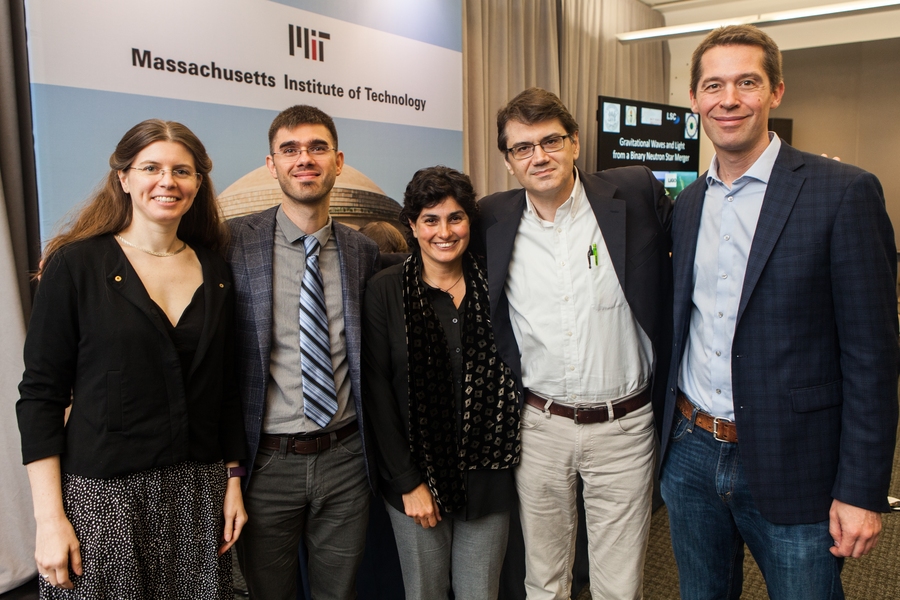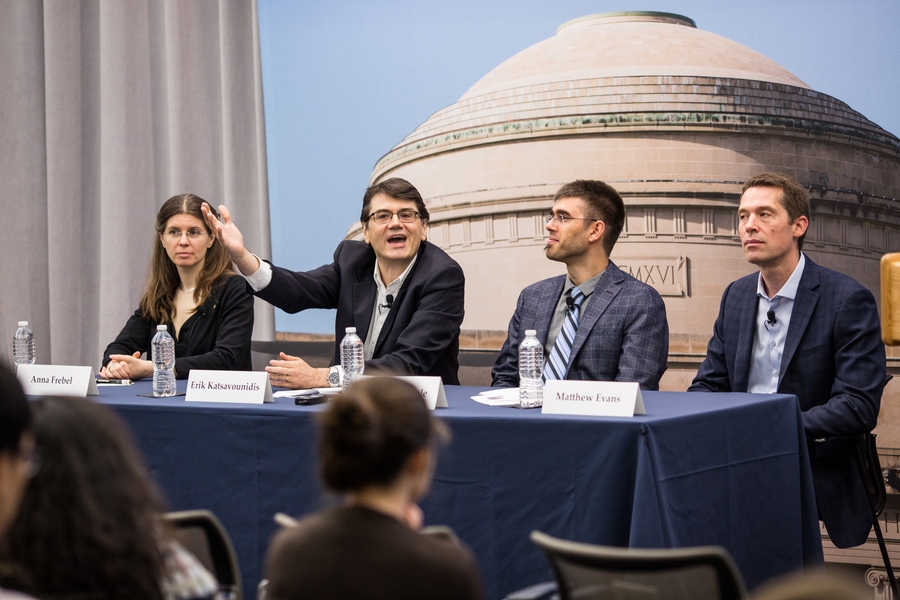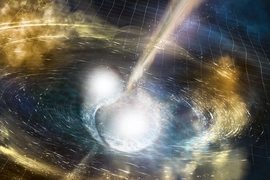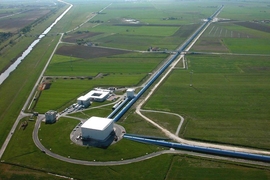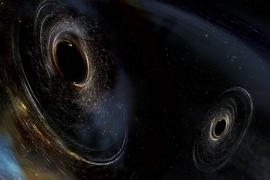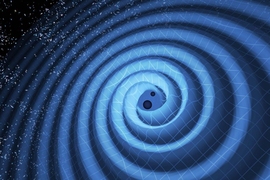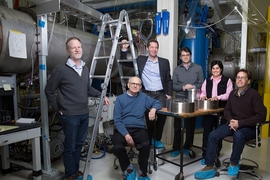On Monday, Oct. 16, scientists from the National Science Foundation (NSF), representatives from the Laser Interferometer Gravitational-Wave Observatory (LIGO) Scientific Collaboration, and other researchers from ground-based and space-based observatories around the world announced the detection of GW170817 — gravitational waves resulting from the merger of two neutron stars.
This detection was the first correlation between gravitational waves and electromagnetic signals in the form of gamma ray bursts and X-ray, ultraviolet, optical, infrared, and radio waves.
Following the live webcast of the announcement made from the National Press Club in Washington, MIT President L. Rafael Reif opened the remarks for an on-campus panel.
“Today is a wonderful reminder that investing in basic science is investing in our nation’s future,” he told the crowd in the Vannevar Bush Room.
Reif then acknowledged the vision of luminaries like Bush, the former MIT dean of engineering, who helped establish what would later become the NSF, the funding agency that has supported the development of the LIGO and Advanced LIGO projects over many decades.
“Bush and his colleagues understood that that basic science can be electrifying, revolutionary, and catalytic. But they also knew that the work that produces fundamental breakthroughs is painstaking, rigorous, and slow,” he said. “For that reason, basic science requires the deep, steady support that only government can provide.”
Reif then introduced Nergis Mavalvala, the Curtis and Kathleen Marble Professor of Astrophysics — “a LIGO pioneer in her own right” — who began her career as a graduate student of MIT Professor Emeritus Rainer Weiss, the winner of the 2017 Nobel Prize in physics for his work on LIGO.
Mavalvala led a panel of MIT scientists in a discussion of the science of the discovery and of its importance in opening up a new field of astronomical discovery.
Multi-messenger astronomy
“I’d always believed that gravitational waves would reveal more of the universe to us — that there would be many more discoveries. But I have to say that I didn’t imagine that it would be quite so soon and certainly not as spectacular,” said Mavalvala. “The combination of gravitational waves and electromagnetic observation, the show that we’ve put together of sound and light, has really blown away most of us in the field.”
The inspiraling of the neutron stars produced gravitational waves that were detected for more than a minute with the LIGO detectors, and the additional “messengers” from the event, in the form of visible light and X-ray and radio waves, lasted for days after the cataclysmic event.
The neutron star merger occurred as part of the constellation we know as Hydra in the galaxy NGC4993, only 130 million light years away as compared with LIGO and Virgo’s most recent black hole merger detection nearly 1.8 billion light years away.
Mavalvala said the researchers had heard scientists at the DC press event say that the event happened in “a galaxy far away,’” but by astronomers’ standards, it actually happened in a galaxy “near away.”
We are made of “neutron star stuff”
The astronomical event also confirmed the theory that the collision of these super dense neutron stars produced elements heavier than iron in the periodic table. Mavalvala first asked Anna Frebel, the Silverman (1968) Family Career Development Associate Professor of Physics, to speak about the neutron start collision as the “factories where these heavy elements are produced.”
Frebel began with the famous quote from Carl Sagan: “We are made from star stuff.”
“After today, we know a lot more about what that ‘star stuff actually’ is and how it’s made,” said Frebel, who is not on the LIGO or Virgo teams. “We can confidently add ‘and neutron star stuff’” to the list of what humans are made from, she said.
To create elements heavier than iron, neutrons must bombard something like an iron nucleus that would ultimately decay and form a stable element like silver or gold. “When you have two neutron stars colliding, you have neutrons galore,” said Frebel. “We had indication before [this event detection] that only neutron star merger can produce these elements. No other site has enough ‘oopmf.’”
The importance of this merger event, said Frebel, is that “we can actually see element formation in action.”
In the decay of these neutron-rich isotopes to stable elements, light is emitted and can be can be observed with light-collecting telescopes as a “‘kilonova’, this afterglow of element production,” she said. Though the creation of the isotopes only takes one or two seconds, Frebel said, the decay to stable elements take a couple weeks to occur. Scientists therefore have a long window to be able to make observations of this event.
Erik Katsavounidis, a senior research scientist in MIT’s Kavli Institute for Astrophysics and Space Research, added that the event “is not just a gold mine scientifically, but it’s literally a gold mine that we’ve just discovered.”
Katsavounidis then responded to a question about whether the event shed new insight into the rate of formation of these neutron star mergers given the amount of heavy elements, such as gold and platinum, present in the Earth’s crust.
Though it was known that supernovae could produce heavier elements, said Katsavounidis, astrophysicists theorized that only a kilonova produced by a binary neutron star merger could produce the abundance of those elements in our solar system.
Salvatore Vitale, an assistant professor of physics, continued the discussion by commenting on the rate of discovery of these events.
“Once LIGO is at its full design sensitivity,” said Vitale, “it would be on the order of 40 to 50 neutron stars per year.”
“We have about a factor of 2 to go from the current sensitivity and the design and that corresponds to roughly a factor of 10 in terms of the rate,” said Matthew Evans, the D. Reid Weedon, Jr. '41 Career Development Professor of Physics and an expert in the design of the interferometers.
“It’s not strange that we saw one of these with our current sensitivity,” said Evans, “But as we go forward with the design, we’ll have several per year.”
Katsavounidis clarified that the rate of detecting an event similar to GW170817 is still unknown because it’s not a given that a neutron star merger would necessarily be accompanied by electromagnetic radiation as seen in this most recent event.
In addition to shedding light on the formation of heavy elements and the rate at which scientists predict these types of events might occur, Mavalvala later added that the detection solves a “decades-long mystery” of the origin of short-duration gamma ray bursts. The Fermi Gamma-ray Space telescope recorded a gamma ray burst on Aug. 17, performing just as intended and as it does with bursts that occur more than 200 times a year. The difference was the near-simultaneous gravitational-wave detection from the LIGO-Virgo global network of interferometers that linked the two events.
When asked about how more than 70 space research labs and telescopes could have so quickly coordinated to observe this event, Katsavounidis said that a coordinated effort was put into place beginning more than 10 years ago for rapid analysis, coordination, and communication.
He then showed a slide of how the event unfolded over time from first the gravitational wave signal lasting just over a minute to electromagnetic radiation that could be observed for days to weeks after the event.
“[It’s like] you’re staring at Van Gogh’s Starry Night and there are 11 swirly stars,” said Katsavounidis. “And you’re listening to Benny Goodman do the glissando at the opening [of Gershwin ‘Rhapsody in Blue’] and then you see the 12th swirly star.”
As to whether the final object in the sky is, in fact, another neutron star or a black hole is currently a puzzle for astronomers to work out. “[The answer] depends on how squishy the neutron stars are and how much mass they can support before they collapse into a black hole,” said Vitale. “That’s one of the things we don’t know yet."
